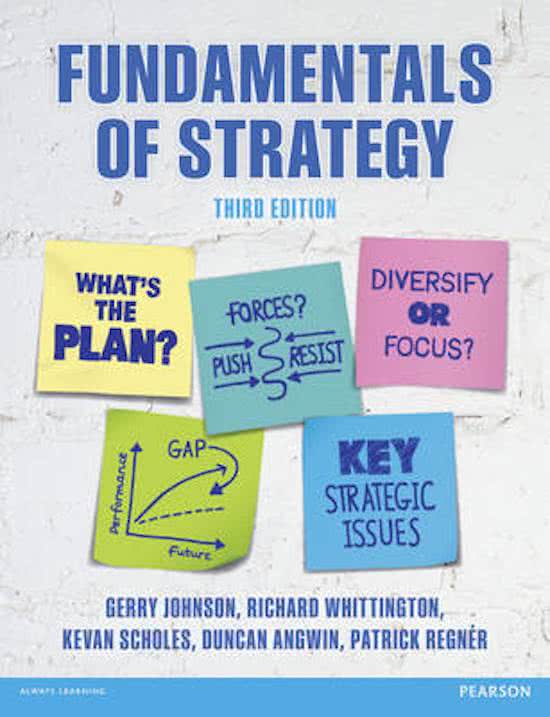Summary advanced management – chapter 1
1. What is strategy?
Three definitions:
(1) The determination of the long-run goals and objectives of an enterprise and the adoption of
courses of action and the allocation of resources
(2) A pattern in a stream of decisions
(3) The long-term direction of an organisation -> definition of the book
Three elements within the definition: the long-term direction of an organisation
(1) The long term: strategies are typically measured over years, for some organisations a decade
or more. The importance of a long-term perspective on strategy is emphasized by the ‘three-
horizons’ framework.
Three-horizons framework: suggest organisations should think of themselves as comprising three
types of business or activity, defined by their ‘horizons’ in terms of years.
Horizon 1: Extend and defend core business – original activities within the business
Vice media: the original Vice magazine
Horizon 2: Build emerging business – businesses are emerging activities that should
provide new sources of profit
Vice media: the new China business
Horizon 3: Create viable options – possibilities, for which nothing is sure. These are
typically risky research and development projects, start-up ventures, test-
market pilots or similar.
Vice media: gaming and sports initiatives
> might generate profits only a couple of years from the present time or might
be a decade ahead. In pharmaceutical company, where the R&D and
regulatory processes for a new drug take many years.
The basic point about the ‘three-horizons’ framework is that managers need to avoid focusing
on the short term issues of their existing activities.
(2) Strategy direction:
(3) Organisation: involve complex relationships, both internally and externally. This is because
organisations typically have many internal and external stakeholders, in other words people
and groups that depend on the organisation and upon which the organisation itself depends.
Internally, organisations are filled with people, typically with diverse, competing and
more or less reasonable views of what should be done. In strategy, therefore, it is always
important to look inside organisations and to consider the people involved and their different
interests and views.
Externally, organisations are surrounded by important relationships, for example with
suppliers, customers, alliance partners and investors. Strategy is therefore also crucially
concerned with an organisation’s external boundaries: in other words, questions about what to
include within the organisation and how to manage important relationships with what is kept
outside.
1. What is strategy?
Three definitions:
(1) The determination of the long-run goals and objectives of an enterprise and the adoption of
courses of action and the allocation of resources
(2) A pattern in a stream of decisions
(3) The long-term direction of an organisation -> definition of the book
Three elements within the definition: the long-term direction of an organisation
(1) The long term: strategies are typically measured over years, for some organisations a decade
or more. The importance of a long-term perspective on strategy is emphasized by the ‘three-
horizons’ framework.
Three-horizons framework: suggest organisations should think of themselves as comprising three
types of business or activity, defined by their ‘horizons’ in terms of years.
Horizon 1: Extend and defend core business – original activities within the business
Vice media: the original Vice magazine
Horizon 2: Build emerging business – businesses are emerging activities that should
provide new sources of profit
Vice media: the new China business
Horizon 3: Create viable options – possibilities, for which nothing is sure. These are
typically risky research and development projects, start-up ventures, test-
market pilots or similar.
Vice media: gaming and sports initiatives
> might generate profits only a couple of years from the present time or might
be a decade ahead. In pharmaceutical company, where the R&D and
regulatory processes for a new drug take many years.
The basic point about the ‘three-horizons’ framework is that managers need to avoid focusing
on the short term issues of their existing activities.
(2) Strategy direction:
(3) Organisation: involve complex relationships, both internally and externally. This is because
organisations typically have many internal and external stakeholders, in other words people
and groups that depend on the organisation and upon which the organisation itself depends.
Internally, organisations are filled with people, typically with diverse, competing and
more or less reasonable views of what should be done. In strategy, therefore, it is always
important to look inside organisations and to consider the people involved and their different
interests and views.
Externally, organisations are surrounded by important relationships, for example with
suppliers, customers, alliance partners and investors. Strategy is therefore also crucially
concerned with an organisation’s external boundaries: in other words, questions about what to
include within the organisation and how to manage important relationships with what is kept
outside.


